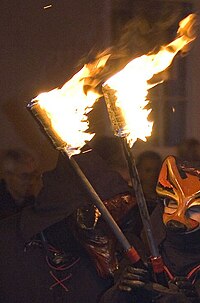熒
| ||||||||
Translingual
[edit]Han character
[edit]熒 (Kangxi radical 86, 火+10, 14 strokes, cangjie input 火火月火 (FFBF) or 難火火月火 (XFFBF), four-corner 99809, composition ⿱𤇾火)
Derived characters
[edit]References
[edit]- Kangxi Dictionary: page 679, character 21
- Dai Kanwa Jiten: character 19304
- Dae Jaweon: page 1091, character 7
- Hanyu Da Zidian (first edition): volume 3, page 2225, character 2
- Unihan data for U+7192
Chinese
[edit]| trad. | 熒 | |
|---|---|---|
| simp. | 荧 | |
Glyph origin
[edit]| Historical forms of the character 熒 | |
|---|---|
| Western Zhou | Shuowen Jiezi (compiled in Han) |
| Bronze inscriptions | Small seal script |

|

|
| Old Chinese | |
|---|---|
| 鶯 | *qreːŋ |
| 罃 | *qreːŋ |
| 嫈 | *qreːŋ, *qreːŋs, *qʷeŋ |
| 褮 | *qreːŋ, *qʷeŋ, *ɢʷeːŋ |
| 覮 | *pqʰʷeːŋ |
| 謍 | *qʰʷreːŋ, *qʷreːŋ, *ɢʷeŋ |
| 䁝 | *qʷraːŋʔ |
| 嶸 | *ɢʷreːŋ, *ɢʷreŋ |
| 嵤 | *ɢʷreːŋ |
| 榮 | *ɢʷreŋ |
| 瑩 | *ɢʷreŋ, *qʷeːŋs |
| 蠑 | *ɢʷreŋ |
| 禜 | *ɢʷreŋ, *ɢʷreŋs |
| 醟 | *ɢʷreŋs, *qʰʷeŋs |
| 檾 | *kʰʷeŋʔ, *kʰʷeːŋʔ |
| 煢 | *ɡʷeŋ |
| 焭 | *ɡʷeŋ |
| 縈 | *qʷeŋ |
| 營 | *ɢʷeŋ |
| 鎣 | *ɢʷeŋ, *qʷeːŋs |
| 塋 | *ɢʷeŋ |
| 濴 | *ɢʷeŋ |
| 熒 | *ɡʷeːŋ |
| 螢 | *ɡʷeːŋ |
| 滎 | *ɡʷeːŋ |
| 濙 | *qʷeːŋʔ |
| 瀅 | *qʷeːŋs |

Pictogram (象形) – The protoform is 𤇾. 𤇾 is a pictogram of two intersecting torches, meaning the fire light. In Qin and Han, the crossing of the torches "乂" became "冂", and "𤇾" is no longer used as independent character as a third "火" (fire) was added into "𤇾". Thus, "熒" was formed.
Etymology
[edit]熒 (OC wêŋ) belongs to a word-family whose stem is *weŋ "bright, dazzle", which converges with 瞬 (OC *win) "to move the eyes" (Schuessler, 2007). Other items in the same word-family are:
- 眩 (OC wîn(s)?, “troubled sight, deluded, deceive”),
- 炫 (OC wîns, “bright, dazzle, show off”),
- 瑩 (OC wreŋ, “bright, color of jade > kind of gem”)
- 熲 (OC kwêŋʔ, “light, flame, blaze”), which is 熒 (OC wêŋ) with *k- nominalizer.
- 榮 (OC wreŋ, “flower > flowering, prosperity > glory”), which is the same word as 熒 (OC wêŋ).
This word-family could be Proto-Sino-Tibetan and related to Mizo ven & veng (“to be open; to be unobstructed by trees, clouds, etc; to be clear; to be free of clouds; to be bright (as weather)”) (ibid.).
Pronunciation
[edit]- Mandarin
- (Standard Chinese)+
- Hanyu Pinyin:
- Zhuyin: ㄧㄥˊ
- Tongyong Pinyin: yíng
- Wade–Giles: ying2
- Yale: yíng
- Gwoyeu Romatzyh: yng
- Palladius: ин (in)
- Sinological IPA (key): /iŋ³⁵/
- (Standard Chinese)+
- Cantonese
- (Standard Cantonese, Guangzhou–Hong Kong)
- Jyutping: jing4
- Yale: yìhng
- Cantonese Pinyin: jing4
- Guangdong Romanization: ying4
- Sinological IPA (key): /jɪŋ²¹/
- (Standard Cantonese, Guangzhou–Hong Kong)
- Southern Min
- Middle Chinese: hweng
- Old Chinese
- (Baxter–Sagart): /*[N]-qʷˤeŋ/
- (Zhengzhang): /*ɡʷeːŋ/
Definitions
[edit]熒
- luminous; fluorescent
- to shine; to shimmer; to dazzle
Compounds
[edit]Further reading
[edit]- “熒”, in 漢語多功能字庫 (Multi-function Chinese Character Database)[1], 香港中文大學 (the Chinese University of Hong Kong), 2014–
Japanese
[edit]Kanji
[edit]- Alternative form of 螢 (luminous, fluorescent)
Readings
[edit]- Go-on: ぎょう (gyō)←ぎやう (gyau, historical)
- Kan-on: けい (kei)←けい (kei, historical)←くゑい (kwei, ancient)
- Kun: ほたる (hotaru, 熒)
Korean
[edit]Etymology
[edit](This etymology is missing or incomplete. Please add to it, or discuss it at the Etymology scriptorium. Particularly: “Middle Korean readings, if any”)
Pronunciation
[edit]- (SK Standard/Seoul) IPA(key): [çʌ̹ŋ]
- Phonetic hangul: [형]
Hanja
[edit]熒 • (hyeong) (hangeul 형, revised hyeong, McCune–Reischauer hyŏng, Yale hyeng)
Vietnamese
[edit]Han character
[edit]- This term needs a translation to English. Please help out and add a translation, then remove the text
{{rfdef}}.
- CJK Unified Ideographs block
- Han script characters
- Translingual lemmas
- Translingual symbols
- Han pictograms
- Chinese terms inherited from Proto-Sino-Tibetan
- Chinese terms derived from Proto-Sino-Tibetan
- Chinese lemmas
- Mandarin lemmas
- Cantonese lemmas
- Hokkien lemmas
- Middle Chinese lemmas
- Old Chinese lemmas
- Chinese hanzi
- Mandarin hanzi
- Cantonese hanzi
- Hokkien hanzi
- Middle Chinese hanzi
- Old Chinese hanzi
- Chinese nouns
- Mandarin nouns
- Cantonese nouns
- Hokkien nouns
- Middle Chinese nouns
- Old Chinese nouns
- Chinese verbs
- Mandarin verbs
- Cantonese verbs
- Hokkien verbs
- Middle Chinese verbs
- Old Chinese verbs
- Chinese adjectives
- Mandarin adjectives
- Cantonese adjectives
- Hokkien adjectives
- Middle Chinese adjectives
- Old Chinese adjectives
- Chinese terms with IPA pronunciation
- Chinese terms spelled with 熒
- Japanese kanji
- Japanese hyōgai kanji
- Japanese kanji with goon reading ぎょう
- Japanese kanji with historical goon reading ぎやう
- Japanese kanji with kan'on reading けい
- Japanese kanji with historical kan'on reading けい
- Japanese kanji with ancient kan'on reading くゑい
- Japanese kanji with kun reading ほたる
- Korean lemmas
- Korean hanja
- Vietnamese lemmas
- Vietnamese Han characters

